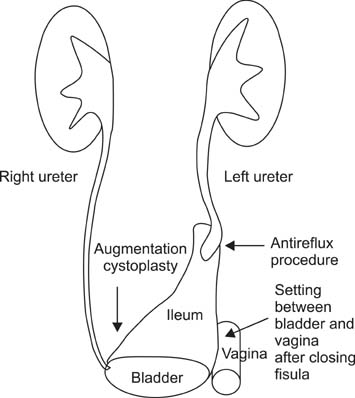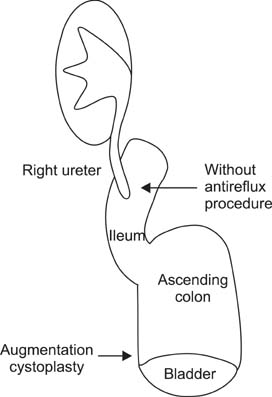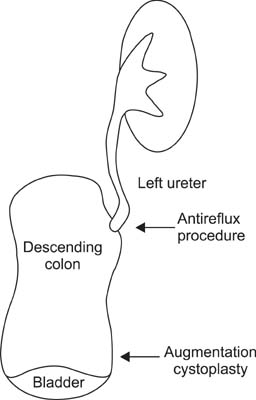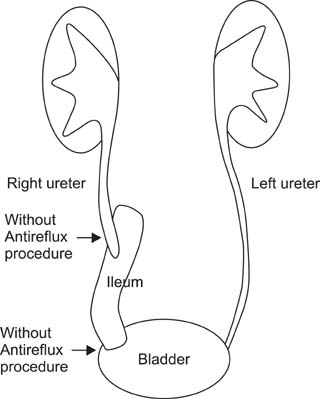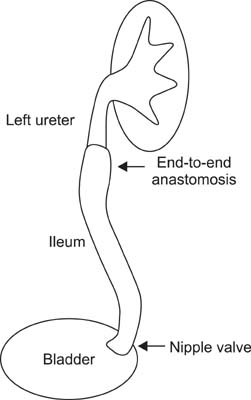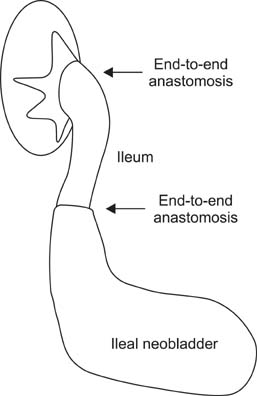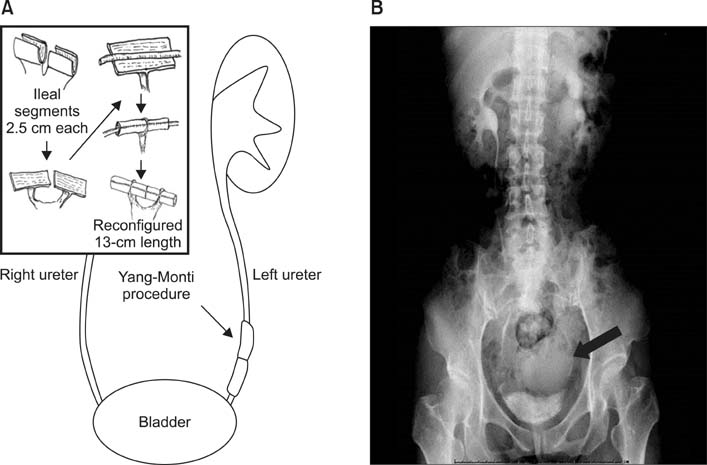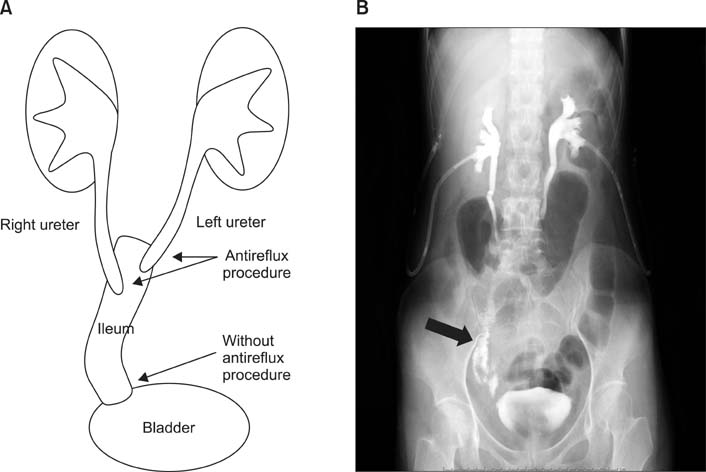Korean J Urol.
2014 Nov;55(11):742-749. 10.4111/kju.2014.55.11.742.
Ureteral Reconstruction With Bowel Segments: Experience With Eight Patients in a Single Institute
- Affiliations
-
- 1Department of Urology, Sapporo Medical University School of Medicine, Sapporo, Japan. masumori@sapmed.ac.jp
- KMID: 2069917
- DOI: http://doi.org/10.4111/kju.2014.55.11.742
Abstract
- PURPOSE
Although replacement of the ureter with a bowel segment is indicated for large ureteral defects, it is still a challenging technique for urologists. We present our experience and outcome of ureteral reconstruction using bowel segments.
MATERIALS AND METHODS
Ureteral reconstruction with bowel segments was performed in eight patients in our institute between 1969 and 2009. We investigated the position and length of the ureteral defect and methods of reconstruction as well as the patients' backgrounds, postoperative complications, and clinical outcomes.
RESULTS
Five patients underwent ureteral replacement with isolated ileal segments alone. In one patient, the ureter was reconstructed by using the Yang-Monti procedure with the ileum. A colon segment was used in two patients who required bladder augmentation for tuberculous contracted bladder at the same time. Metabolic acidosis occurred in three patients having a solitary kidney and the ureter had to be replaced by a relatively long intestinal segment. Two patients who received preoperative radiation therapy were required to undergo additional operations. Long-term cancer-free survival was achieved in one patient who underwent ileal substitution for low-grade renal pelvic cancer.
CONCLUSIONS
Although ureteral replacement with a bowel segment is a challenging and useful procedure, attention must be paid to the possibility of metabolic acidosis, which is likely to occur in patients having a solitary kidney with renal insufficiency or in patients requiring a long intestinal segment for reconstruction. In addition, preoperative radiation therapy for the pelvic organs may cause postoperative complications.
Keyword
MeSH Terms
Figure
Cited by 1 articles
-
Feasibility of Polycaprolactone Scaffolds Fabricated by Three-Dimensional Printing for Tissue Engineering of Tunica Albuginea
Ho Song Yu, Jinju Park, Hyun-Suk Lee, Su A Park, Dong-Weon Lee, Kwangsung Park
World J Mens Health. 2018;36(1):66-72. doi: 10.5534/wjmh.17025.
Reference
-
1. Dhal DM, McDougal WS. Use of intestinal segments in urinary diversion. In : Wein AJ, Kavoussi LR, Novick AC, Partin AW, Peters CA, editors. Campbell-Walsh urology. 9th ed. Philadelphia: Saunders;2007. p. 2534–2578.2. Harzmann R, Kopper B, Carl P. Cancer induction by urinary drainage or diversion through intestinal segments? Urologe A. 1986; 25:198–203.3. Hsu THS, Streem SB, Nakada SY. Management of upper urinary tract obstruction. In : Wein AJ, Kavoussi LR, Novick AC, Partin AW, Peters CA, editors. Campbell-Walsh urology. 9th ed. Philadelphia: Saunders;2007. p. 1227–1273.4. Shoemaker GE. Removal of the ureter with a tuberculous kidney. Ann Surg. 1911; 53:696–698.5. Chung BI, Hamawy KJ, Zinman LN, Libertino JA. The use of bowel for ureteral replacement for complex ureteral reconstruction: long-term results. J Urol. 2006; 175:179–183.6. Armatys SA, Mellon MJ, Beck SD, Koch MO, Foster RS, Bihrle R. Use of ileum as ureteral replacement in urological reconstruction. J Urol. 2009; 181:177–181.7. Wolff B, Chartier-Kastler E, Mozer P, Haertig A, Bitker MO, Roupret M. Long-term functional outcomes after ileal ureter substitution: a single-center experience. Urology. 2011; 78:692–695.8. Kawanishi H, Aoyama T, Sasaki M. Long-term results of ureteral replacement using ileum: report of four cases. Hinyokika Kiyo. 1999; 45:431–434.9. Takahashi A, Tsukamoto T, Kumamoto Y, Sato Y, Shibuya A, Sato M. Adenocarcinoma arising in the ileal segment of a defunctionalized ileocystoplasty. Hinyokika Kiyo. 1993; 39:753–755.10. Nesbit RM. Ureterosigmoid anastomosis by direct elliptical connection. Univ Hosp Bull. 1948; 14:45.11. Tscholl R, Tettamanti F, Zingg E. Ileal substitute of ureter with reflux-plasty by terminal intussusception of bowel: animal experiments and clinical experience. Urology. 1977; 9:385–389.12. Le Duc A, Camey M, Teillac P. An original antireflux ureteroileal implantation technique: long-term followup. J Urol. 1987; 137:1156–1158.13. Mattos RM, Smith JJ 3rd. Ileal ureter. Urol Clin North Am. 1997; 24:813–825.14. Ravi R, Dewan AK, Pandey KK. Transverse colon conduit urinary diversion in patients treated with very high dose pelvic irradiation. Br J Urol. 1994; 73:51–54.15. Hinman AR, Farmer PE. The coalition for cholera prevention and control meeting. Vaccine. 2013; 31:2323.16. Ali-el-Dein B, Ghoneim MA. Bridging long ureteral defects using the Yang-Monti principle. J Urol. 2003; 169:1074–1077.17. Castellan M, Gosalbez R. Ureteral replacement using the Yang-Monti principle: long-term follow-up. Urology. 2006; 67:476–479.18. Pope J, Koch MO. Ureteral replacement with reconfigured colon substitute. J Urol. 1996; 155:1693–1695.19. Ubrig B, Roth S. Reconfigured colon segments as a ureteral substitute. World J Urol. 2003; 21:119–122.20. Ubrig B, Waldner M, Roth S. Reconstruction of ureter with transverse retubularized colon segments. J Urol. 2001; 166:973–976.21. Goodwin WE, Scardino PT. Ureterosigmoidostomy. J Urol. 1977; 118(1 Pt 2):169–174.22. Kato H, Abol-Enein H, Igawa Y, Nishizawa O, Ghoneim MA. A case of ileal ureter with proximal antireflux system. Int J Urol. 1999; 6:320–323.23. Waldner M, Hertle L, Roth S. Ileal ureteral substitution in reconstructive urological surgery: is an antireflux procedure necessary? J Urol. 1999; 162:323–326.24. Bazeed MA, El-Rakhawy M, Ashamallah A, El-Kappany H, El-Hammady S. Ileal replacement of the bilharzial ureter: is it worthwhile? J Urol. 1983; 130:245–248.25. Boxer RJ, Fritzsche P, Skinner DG, Kaufman JJ, Belt E, Smith RB, et al. Replacement of the ureter by small intestine: clinical application and results of the ileal ureter in 89 patients. J Urol. 1979; 121:728–731.
- Full Text Links
- Actions
-
Cited
- CITED
-
- Close
- Share
- Similar articles
-
- Outcomes of single-port robotic ureteral reconstruction using the da Vinci SP® system
- Clinical Observation on Substitute Bladders Replaced with Isolated Intestinal Segments
- Ectopic ureterocele in children
- Robot-assisted distal ureteral reconstruction for benign pathology: Current state
- Experience of Ureteroscopic Removal of Ureteral Stone in 35 Cases

